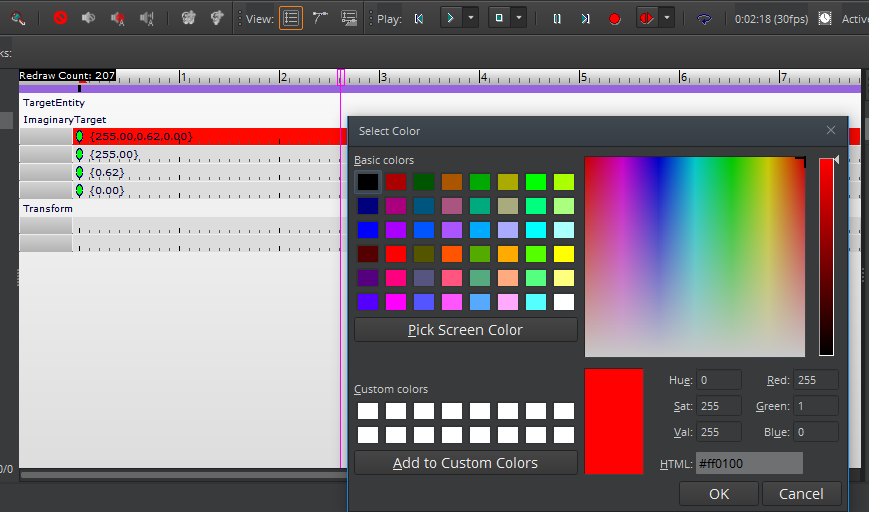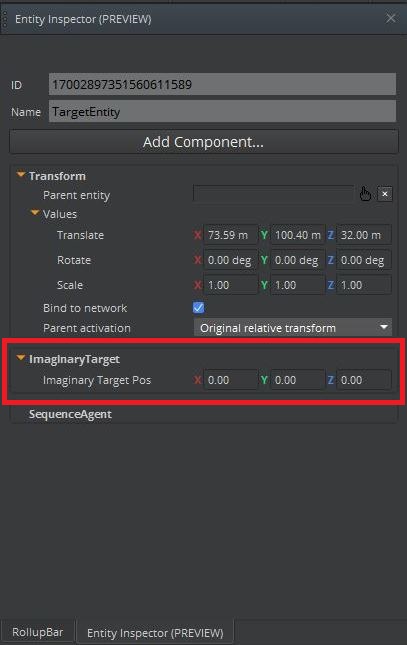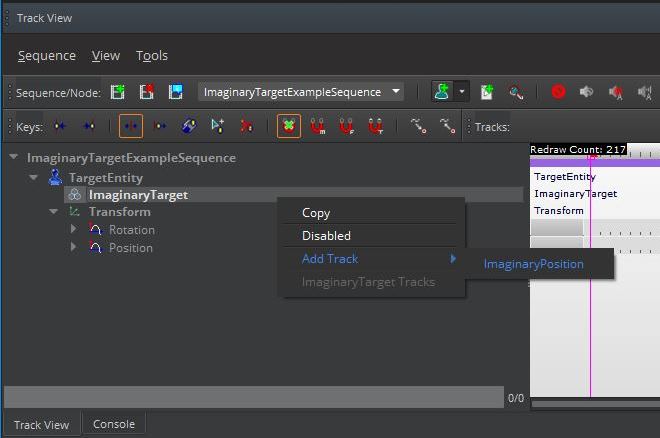IN THIS ARTICLE
将自定义组件暴露给Track View视图
要在电影剪辑场景和渲染到磁盘的影片中加入自定义组件,必须在 O3DE 的 Track View和Entity Inspector中公开可动画组件的属性。要公开自定义组件及其属性,必须执行三个步骤:
在组件的一个请求事件总线上为 可以制作动画的 属性创建获取和设置方法。
在组件中实施 getter 和 setter 请求处理程序。
将组件反射到编辑上下文和行为上下文中。编辑上下文反射会在Entity Inspector中显示组件,而行为上下文反射会在 Track View中显示组件。
公开自定义组件:示例
下面的示例假设创建了一个名为 ImaginaryTargetComponent 的自定义组件。该组件有一个名为ImaginaryPosition的 Vector3 属性,您希望在Track View中对其进行动画处理。还为该组件创建了名为 ImaginaryTargetComponentBus 的请求总线。本示例假定您熟悉事件总线和组件处理程序的编程。有关详细信息,请参阅
使用事件总线 (EBus) 系统 和
创建组件。
要将自定义组件公开到 Track View
创建getter和setter方法
每个属性都必须提供一个方法来设置其值和获取其当前值。要实现这一点,可在组件的一个请求总线上创建 setter 和 getter 方法。然后将这些方法反射到行为上下文中,作为组件类反映的一部分。
下面的示例在
ImaginaryTargetComponentRequestBus上创建了 setter 和 getter 请求。/*! * ImaginaryTargetComponentRequests EBus Interface * Messages serviced by ImaginaryTargetComponents. */ class ImaginaryTargetComponentRequests : public AZ::ComponentBus { public: // EBusTraits overrides - Application is a singleton. // Only one component on an entity can implement the events. static const AZ::EBusHandlerPolicy HandlerPolicy = AZ::EBusHandlerPolicy::Single; // Getter/Setter methods for ImaginaryTargetPosition. virtual AZ::Vector3 GetImaginaryTargetPosition() = 0; virtual void SetImaginaryTargetPosition(const AZ::Vector3& newPosition) = 0; }; using ImaginaryTargetComponentRequestBus = AZ::EBus<ImaginaryTargetComponentRequests>;在组件中实现处理程序
在组件中为第一步中声明的 setter 和 getter 请求执行处理程序,如下面的示例。
class ImaginaryTargetComponent : public AzToolsFramework::Components::EditorComponentBase , public LmbrCentral::ImaginaryTargetComponentRequestBus::Handler { public: AZ_EDITOR_COMPONENT(ImaginaryTargetComponent, "{4491D282-C120-4B2E-BC63-AC86296956A2}"); ImaginaryTargetComponent() : m_imaginaryPosition(.0f) {}; // ImaginaryTargetComponentRequestBus::Handler implementation. // Implementations for Getter/Setter methods for ImaginaryTargetPosition. // Presumably these would be used for something useful; this example just // stores and returns the value. AZ::Vector3 GetImaginaryTargetPosition() override { return m_imaginaryPosition; } void SetImaginaryTargetPosition(const AZ::Vector3& newPosition) override { m_imaginaryPosition = newPosition; } protected: // Required Reflect function. static void Reflect(AZ::ReflectContext* context); private: AZ::Vector3 m_imaginaryPosition; };反射组件
使用编辑上下文和行为上下文,反射组件的类、请求事件总线以及设置器和获取器方法。Track View会使用您在此步骤中反映的setter和getter方法来设置和获取动画属性的值。您还必须反映一个
VirtualProperty声明,告诉 Track View 您的组件能够被动画化。/*static*/ void ImaginaryTargetComponent::Reflect(AZ::ReflectContext* context) { AZ::SerializeContext* serializeContext = azrtti_cast<AZ::SerializeContext*>(context); if (serializeContext) { serializeContext->Class<ImaginaryTargetComponent, AzToolsFramework::Components::EditorComponentBase>() ->Version(0) ->Field("ImaginaryPosition", &ImaginaryTargetComponent::m_imaginaryPosition); AZ::EditContext* editContext = serializeContext->GetEditContext(); if (editContext) { editContext->Class<ImaginaryTargetComponent>("ImaginaryTarget", "A Code Sample enabling Track View Animation") ->ClassElement(AZ::Edit::ClassElements::EditorData, "") ->Attribute(AZ::Edit::Attributes::Category, "Game") ->Attribute(AZ::Edit::Attributes::AppearsInAddComponentMenu, AZ_CRC("Game", 0x232b318c)) ->DataElement(0, &ImaginaryTargetComponent::m_imaginaryPosition, "Imaginary Target Pos", "Imaginary Target Position") ; } } AZ::BehaviorContext* behaviorContext = azrtti_cast<AZ::BehaviorContext*>(context); if (behaviorContext) { // Reflect the setter and getter methods and create a virtual property that refers to them. behaviorContext->EBus<ImaginaryTargetComponentRequestBus>("ImaginaryTargetRequestBus") ->Event("GetImaginaryTargetPosition", &ImaginaryTargetComponentRequestBus::Events::GetImaginaryTargetPosition) ->Event("SetImaginaryTargetPosition", &ImaginaryTargetComponentRequestBus::Events::SetImaginaryTargetPosition) ->VirtualProperty("ImaginaryPosition", "GetImaginaryTargetPosition", "SetImaginaryTargetPosition"); // Attach the "ImaginaryTargetRequestBus" EBus that you reflected to the behavior context of the ImaginaryTargetComponent class. behaviorContext->Class<ImaginaryTargetComponent>()->RequestBus("ImaginaryTargetRequestBus"); } }(可选)在获取器上放置单位属性
Track View 的用户界面取决于 getter 和 setter 所使用的数据类型。前述示例使用的数据类型是
AZ::Vector3,因此 Track View 从属性中创建了一个复合的x,y,z轨迹。相比之下,如果获取器和设置器使用了bool类型,Track View就会创建一个布尔轨迹。对于大多数可动画属性来说,使用这种类型就足够了。但在某些情况下,您可能需要为反射属性设置单位。例如,如果属性的AZ::Vector3表示颜色,则必须在 getter 事件的反射中添加一个属性。该属性指示 Track View 为该属性使用颜色选择器。如果您有一个名为ImaginaryTargetColor的属性,它调用了一个名为GetImaginaryTargetColor的getter事件,请使用如下反射代码:->Event("GetImaginaryTargetColor", &ImaginaryTargetComponentRequestBus::Events::GetImaginaryTargetColor) ->Attribute("Units", AZ::Edit::Attributes:: PropertyUnits8BitColor)如下图所示,Track View会为属性使用颜色轨迹。

其他单位可以在文件
Code\Framework\AZCore\AZCore\Serialization\EditContextConstants.inl中找到。这些单元如下。const static AZ::Crc32 PropertyUnitsRadian = AZ_CRC("Radians"); const static AZ::Crc32 PropertyUnits8BitColor = AZ_CRC("8BitColor");如果您想让 Track View 在用户界面中将以弧度为单位的角度参数转换为度,请使用
AZ::Crc32 PropertyUnitsRadian。
查看结果
现在,您可以查看示例组件和属性在Entity Inspector和跟踪视图中的显示效果。
在下面的Entity Inspector图像中,EditContext反射暴露了ImaginaryTarget组件及其Imaginary Target Pos属性。

在下面的Track View图片中,BehaviorContext反射从相应的虚拟属性中显示了ImaginaryTarget组件和ImaginaryPosition轨迹。

